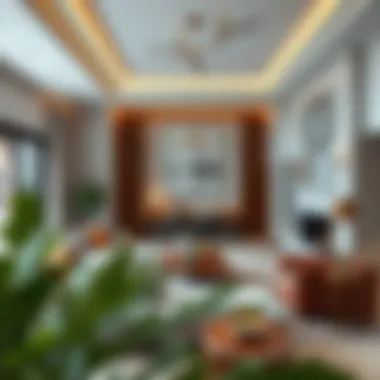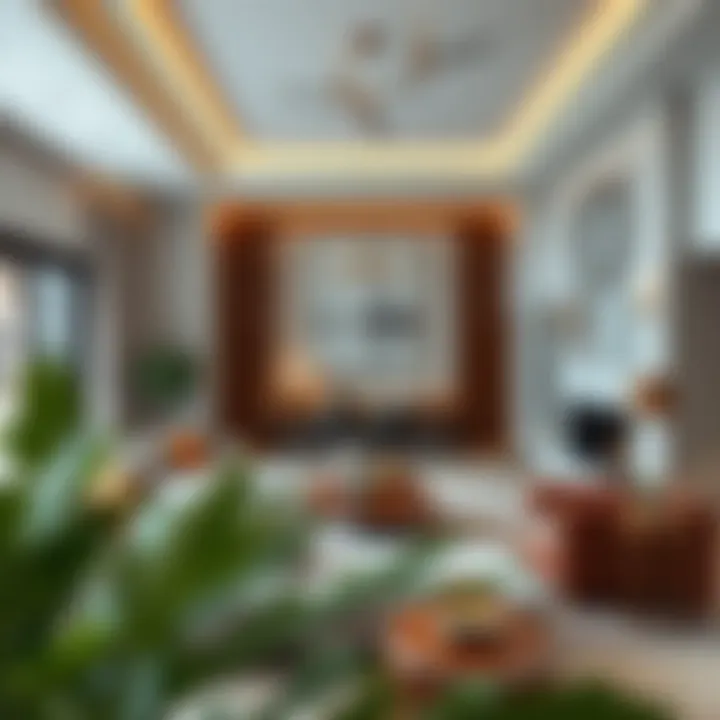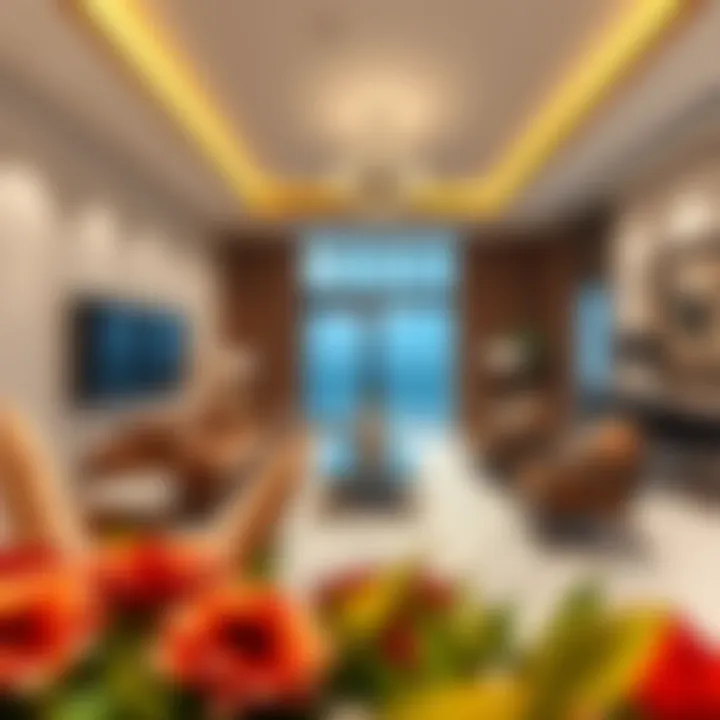Exploring the Karama Family Room: A Comprehensive Guide


Intro
The Karama family room embodies the blend of comfort and cultural richness, making it a focal point in residences throughout Dubai. This particular space is not merely about aesthetics, but it also speaks volumes about the local lifestyle and traditions. In the contemporary real estate climate, understanding the intricacies of the family room is crucial for homeowners and investors alike. By bringing together elements of design, function, and cultural significance, the family room becomes a reflection of personal identity and community values.
As urban developers and homeowners seek to carve out unique living spaces, the family room's importance cannot be understated. It serves as an area where families bond, celebrate, and find solace. Hence, this guide will unfold the nuances of the Karama family room, offering insights that resonate with both emotional attachment and smart investment choices.
Understanding the market trends and investment opportunities surrounding this space can ultimately lead to more enriching living environments, and the overall enhancement of one's lifestyle. This article aims to unpack the layers of this intriguing aspect of Dubai's residential architecture.
Prologue to the Karama Family Room
The significance of the Karama family room in the realm of Dubai's residential architecture cannot be underestimated. This space serves not merely as a gathering area for family but embodies the essence of togetherness and cultural expression unique to this region. More than just a room with four walls, it represents the heart of family life, where memories are created, relationships are strengthened, and heritage is passed down through generations.
Understanding this place is pivotal for homebuyers, investors, and anyone looking to appreciate what living in Dubai truly entails. When one thinks about a family room, it evokes images of comfort and warmth; it’s a domain characterized by its ability to adapt and evolve with the changing dynamics of family life.
Defining the Family Room Concept
At its core, the family room is a multifunctional space designated primarily for relaxation and interaction. It often acts as a casual meeting place away from the more formal settings of a living room. People might gather to watch television, engage in games, or simply share stories. In Dubai, where lifestyles blend modernity with tradition, the design of family rooms reflects this duality, offering a structure that promotes both informal get-togethers and serene solitude.
A notable feature of family rooms in Karama is their inclusive layout, allowing for various activities. Families can sit together on plush sofas or gather around a dinner table, facilitating interaction that is starkly different from the more opulent and separated feelings of formal dining spaces. This room's purpose truly enriches the living experience, fostering strong connections between family members.
Cultural Significance in Dubai
The cultural backdrop plays a crucial role in shaping the family room in Dubai, particularly within neighborhoods like Karama. Historically, family is at the epicenter of Emirati society, and the family room is the embodiment of this value. It encapsulates tradition, heritage, and lifestyle. In many households, the room reflects not just personal style but cultural influences, showcasing elements of Arab hospitality and the deep-seated importance of familial bonds.
Recent trends show that family rooms in Dubai are evolving. While traditional features endure—like comfortable seating and practical layouts—there's a noticeable shift towards modernization. Smart technology is often integrated into these spaces, merging functionality with cultural aesthetics. This interplay illustrates a desire among residents to honor their roots while embracing contemporary living.
In Karama, it's not uncommon to see spaces adorned with intricate Arabian decor alongside contemporary art pieces, blending old and new into a cohesive environment. This reflects the global nature of Dubai, where various cultures intersect, creating a unique tapestry that defines the family room's evolution.
"The family room in Karama is a cultural treasure, encapsulating the values and traditions that define Emirati life."
For those interested in enhancing their living conditions, recognizing the cultural weight carried by the family room can guide thoughtful design choices that resonate with both personal aesthetics and community heritage. As we delve deeper into the architectural features and functional aspects of the Karama family room, it becomes clear that these spaces are foundational to the identity of modern life in Dubai.
Architectural Aspects of Karama Family Rooms
The architectural design of family rooms in Karama plays a pivotal role in shaping not only the aesthetics of residential spaces but also their functionality. As family rooms serve as the heart of a home, understanding their architectural aspects can lead to a better living experience. From the layout to material choices, these elements contribute significantly to how families interact and enjoy their spaces. In this section, we’ll explore the key factors that influence the design of family rooms in Karama, which ultimately cater to the dynamic needs of residents.
Design Elements
Layout Considerations
The layout of a family room is often likened to a puzzle where each piece must fit just right to create a harmonious living environment. In Karama, an open floor plan has gained popularity among homeowners. This design encourages seamless movement between spaces, fostering an inviting atmosphere conducive to socializing.
One key characteristic of an open layout is its ability to maximize natural light, which can make even smaller rooms feel more spacious. Large windows or glass doors can enhance this effect, seamlessly connecting the indoor living area with outdoor spaces. This invites fresh air and greenery, helping to break the monotony of urban living. However, it’s important to bear in mind that an extensive open layout may pose challenges in defining specific areas for various activities, potentially leading to a cluttered appearance if not managed properly.
Material Selection
When it comes to material selection, durability and aesthetic appeal go hand in hand. Family rooms in Karama often feature materials that withstand the rigors of daily life while still appealing to the eye. Common choices include engineered wood flooring, which offers high durability and a warm look, and ceramic tiles that are easy to clean and maintain.
One of the most significant advantages of using high-quality materials is their longevity, thereby reducing the need for frequent replacements. However, it's worth noting that the initial cost can be higher. When selecting materials, homeowners should weigh the long-term benefits against short-term expenditures to make the most informed decision.
Color Schemes
Color schemes in family rooms can transform the way space is perceived. Lighter shades such as soft creams and pastels can create an airy feel, making even compact family rooms seem larger. In contrast, bold colors can serve as focal points, evoking a sense of warmth and vibrancy.
A trending choice in Karama is to blend neutral tones with occasional pops of color through decor or art pieces. This strategy not only satisfies aesthetic preferences but also allows for easy updates, as changing accessories can refresh the entire vibe of a room without a complete overhaul. However, too many contrasting colors might overwhelm the senses, so it’s crucial to find a balance that resonates with the inhabitants.
Space Efficiency Solutions
As urban living in Dubai often comes with its space limitations, the need for efficient design solutions becomes ever more important. Homeowners are increasingly looking for ways to make the most out of their available square footage without compromising on style or comfort.
Multi-Purpose Furniture
Multi-purpose furniture is a practical answer to the challenge of limited space. For instance, a sofa that converts into a bed can accommodate overnight guests without requiring additional rooms. Likewise, nesting tables can be easily tucked away when not in use, allowing for available floor space.


The ability to optimize space is a significant characteristic that makes multi-purpose furniture appealing. It provides ultimate flexibility, adapting to the family's evolving needs over time. However, one must also consider the trade-off between style and functionality, as some multifunctional pieces may sacrifice aesthetic value.
Storage Innovations
Effective storage solutions are crucial in maintaining a clutter-free environment. Innovative designs such as built-in shelves or under-seat storage create hidden nooks for organizing toys, books, and other belongings without cluttering the surface areas.
One notable characteristic of storage innovations is their seamless integration into the room's overall design, enhancing both function and aesthetics. While the initial installation may take some effort, the benefits of having a well-organized family room are immeasurable. The trade-off here could be a more fixed design that may not suit every family’s evolving needs; thus, careful planning is essential.
"Designing a family room isn't just about creating a beautiful space; it's about crafting an environment that fosters connection and joy among loved ones."
In summary, architectural aspects of family rooms in Karama encompass a variety of design elements and innovative solutions that contribute significantly to the comfort, functionality, and overall mood of a home. By considering layout, material selections, color schemes, and space efficiency innovations, homeowners can create environments that support family interactions and enhance daily living.
Functional Role of the Family Room
The family room in a home, particularly in the context of the Karama region, plays a vital role that goes beyond mere aesthetics. It serves as a social hub, a sanctuary for entertainment, and a space designed for nurturing interpersonal relationships. Understanding this multifaceted role helps both homeowners and potential buyers appreciate the value each family room adds to the overall living experience.
Social Interactions
Family rooms are the bedrock for social interactions. They are where families gather after a long day, share meals, discuss events, and create memories that will last a lifetime. Imagine a cozy room, inviting with warm lighting and plush seating, where laughter and conversations flow freely. Such a setting encourages not only immediate family bonding but also deep connections with friends and guests.
The layout of the family room often emphasizes inclusivity. Sofas arranged in a conversational layout, coffee tables that facilitate discussions, and open pathways for ease of movement all contribute to creating a welcoming atmosphere. In addition, decorative elements such as family photographs and artwork add a personal touch, allowing each family member's personality to shine. It becomes a space where all feel valued and heard.
"The family room is not just a space; it's where life unfolds, laughter echoes, and relationships deepen."
Moreover, family rooms foster interaction across generations. In a place like Dubai, where families often consist of multiple generations, the family room becomes a central venue. It adapts to various activities, hosting everything from storytime with children to board games with grandparents. These social dynamics are crucial for maintaining cultural values and ensuring that traditions are passed down.
Entertainment Purposes
On the other hand, the family room serves as an entertainment hub. This space is where families can unwind together, hosting movie nights or engaging in interactive gaming sessions. By integrating technology, such as smart home systems and audiovisual equipment, homeowners can transform a standard family room into a state-of-the-art entertainment center.
Consider a room featuring a large screen and comfy seating—perfect for viewing the latest blockbuster or catching a sports game. Adopting modern design elements, like tiered seating or acoustic panels, can noticeably enhance the viewing experience. Furthermore, having gaming consoles set up can cater to varied interests, from the youngest to the oldest member of the household.
The entertainment aspect of the family room extends beyond passive activities. It encourages active engagement among family members. Table games, arts and crafts, or family cooking sessions can all be facilitated in this versatile space. Mixing leisure with learning encourages creativity and collaboration, creating an enriching environment for all.
Emotional Impact of Family Spaces
Family spaces, particularly the Karama family room, hold significant emotional weight in the fabric of everyday life. These rooms are not merely spots to sit or watch television; they're arenas where family members forge deep connections, share experiences, and celebrate milestones. The emotional impact of these spaces transcends their physical attributes, influencing how individuals interact with one another.
Fostering Family Bonds
The design of a family room plays an integral role in nurturing relationships among family members. For instance, an open layout allows for visual and auditory connections, fostering communication. Imagine a space where parents can cook in the kitchen nearby while children play in the living room. This kind of openness helps everyone feel included, promoting a sense of togetherness.
Creating areas that encourage participation is also critical. Incorporating a large dining table as a central feature within the family room provides a consistent gathering point for meals, discussions, or game nights. During these moments, families actively engage, share stories, and create treasured memories.
Additionally, thoughtful arrangements of seating options can enhance interaction. For example, opting for an L-shaped sofa can create an inviting setup that promotes conversation, allowing family members to face one another comfortably. In contrast, an isolated layout may unintentionally suggest emotional distance.
"A well-designed family room is not just a collection of furniture; it's a platform for relationships to flourish."
Creating a Comfortable Atmosphere
The atmosphere within a family room is fundamental in establishing a sense of comfort and safety. A soothing color palette can significantly affect mood. For instance, soft blues and earth tones can promote tranquility, while vibrant colors like yellows or reds might inspire energy and cheerfulness.
Moreover, personal touches—like family photos, heirlooms, or artwork—carve a unique identity for the space. When individuals surround themselves with items that resonate on a personal level, they create an emotional landscape that feels safe and inviting. The smell of specific fragrances, such as freshly baked cookies or essential oils, can further enhance this calming environment.
Lighting also contributes to the comfort factor. Natural light plays a vital role in brightening moods, while adjustable lighting solutions can cater to various activities—whether it’s a cozy movie night or a lively family gathering.
In the end, family spaces play a role beyond mere decoration. By focusing on how they foster bonds and cultivate a comfortable atmosphere, homeowners can truly elevate their family experiences, making the Karama family room a sanctuary for cherished moments.
Contemporary Design Trends
When exploring the nuances of the Karama family room, it’s crucial to recognize how contemporary design trends play a pivotal role in shaping these spaces. Contemporary design isn’t just about aesthetics; it incorporates functionality, sustainability, and a sense of harmony with one’s lifestyle. It reflects the evolving expectations of homebuyers and tenants, particularly in bustling urban environments like Dubai.
Adopting modern design trends in the family room ensures a blend of comfort and efficiency. Homeowners seek spaces that not only cater to family activities but also resonate with current technological advancements and environmental considerations. From minimalist designs to tech-savvy installations, an understanding of these trends can empower individuals to create a space that not only looks good but feels right.


Minimalist Approaches
The minimalist approach to design has gained traction in family rooms, especially in urban settings where space often comes at a premium. Minimalism is all about stripping away the unnecessary elements and focusing on what truly matters. This design philosophy prioritizes open spaces and functional furniture that encourages ease of movement and reduces clutter.
Incorporating understated color schemes and simple lines contributes to a less chaotic environment, which can be particularly beneficial for family dynamics. Families can engage in activities without feeling overwhelmed by excess items. The essence of a minimalist family room is not just about less stuff; it's about creating a sanctuary where one can unwind and feel at peace.
- Key Benefits of Minimalism:
- Encourages family cohesion by reducing distractions.
- Enhances the perception of space, making rooms feel larger.
- Simplifies cleaning and maintenance tasks, allowing families to enjoy their time together.
Incorporation of Technology
The integration of technology into family rooms showcases a shift towards a more connected lifestyle. Gone are the days when technology merely served a function; now it enhances the overall ambiance and convenience. From smart TVs to interactive lighting systems, technology allows families to tailor their environments to individual needs and preferences.
Smart Home Implementations
One significant aspect of this technological integration is the implementation of smart home systems. These systems offer the ability to control lighting, temperature, and entertainment devices through voice commands or mobile apps. For families in Dubai who gracefully juggle busy schedules, such technology becomes a beneficial ally. The flexibility of controlling home features enhances comfort and accessibility.
- Key Characteristics of Smart Home Implementations:
- Remote Access: Control your home’s features from anywhere, which is great for busy parents.
- Energy Management: Optimize energy usage, contributing to lower utility bills while being eco-friendly.
However, while smart home devices can drastically improve daily life, there’s a learning curve associated with them that some may find challenging. Not everyone is tech-savvy, and that can lead to frustration if systems don’t operate as expected.
Energy Efficiency
Energy efficiency, another vital consideration in contemporary design, aligns closely with sustainability trends. Families today are more conscious of their environmental impact, and creating a family room that promotes energy saving practices is becoming increasingly popular. Thoughtful design choices like energy-efficient appliances and proper insulation not only conserve resources but also bolster the home’s overall value.
- Benefits of Energy Efficiency:
- Reduces carbon footprint and promotes a sustainable environment.
- Leads to significant cost savings over time due to lower energy bills.
- Increases the comfort level within the home by providing stable temperatures.
When it comes to energy efficiency in family rooms, the spotlight is often on utilizing sustainable materials and appliances designed for conservation. Still, while energy-efficient solutions may require a higher initial investment, the long-term benefits can outweigh those costs.
Challenges and Considerations
Navigating the landscape of family room design within the urban setting of Dubai comes with a unique set of challenges. Understanding these obstacles is essential for anyone aiming to create an inviting and functional family space. From space limitations to the delicate balance between aesthetics and functionality, recognizing these challenges can lead to smarter decisions and, ultimately, better designs.
Space Limitations in Urban Environments
Living in a bustling metropolis like Dubai often means contending with limited space. Many residences, particularly in areas like Karama, are characterized by compact layouts. This can significantly impact how a family room is designed and utilized. When square footage is at a premium, one must think twice about each element brought into the space.
- Storage Solutions: Utilizing vertical space can be paramount. Shelving that reaches the ceiling, for instance, can offer ample storage options without consuming valuable floor space.
- Multi-Function Furniture: Selecting furniture that serves dual purposes is clever. A sofa that converts into a bed or a coffee table with hidden storage can make a world of difference in a space where every inch counts.
- Open Layouts: Adapting an open-concept design can create an illusion of spaciousness. By minimizing walls and barriers, light flows more freely, which can help a smaller room feel larger and more inviting.
Reflecting on these solutions, urban dwellers should embrace creativity in overcoming challenges posed by limited dimensions.
Balancing Aesthetics with Functionality
When designing a family room, aesthetics and functionality should not be at odds; instead, they should coexist harmoniously. Achieving this balance is crucial for creating a space that is not only visually appealing but also practical for everyday use.
- Functional Design: You don't want to sacrifice usability for style. A beautifully designed room that can't accommodate a family's needs is a wasted effort. Elements such as large, comfortable sofas promote family bonding, while a well-organized entertainment center can keep gadgets out of sight.
- Personal Touch: Infusing personal touches into the decor can unite functionality with aesthetics. Lady artist known for her bold patterns might create custom cushions that enhance both comfort and style.
- Consistent Theme: Keeping a consistent color scheme and style across furniture and decor elements effectively enhances a room's overall look. Classic pieces should mate gracefully with contemporary styles, showcasing unique tastes while remaining practical.
In sum, striking the right balance requires thoughtful planning. Homeowners can create environments that are as functional as they are beautiful. This delicate interplay between the two can elevate the living experience significantly.
"In design, the trick is to marry functionality and beauty seamlessly, ensuring that one does not overshadow the other."
Understanding these challenges and considerations provides a roadmap for homeowners to follow. Recognizing space limitations can lead to innovative solutions, while balancing aesthetics with functionality ensures the family room is an inviting sanctuary for all, especially in the diverse cultural tapestry of Dubai.
Sustainable Practices in Family Room Design
In the context of residential properties, particularly in a vibrant locale like Dubai, sustainable practices in family room design have gained significant traction. Not only do these practices echo the global push towards sustainability, but they also resonate with the values of environmentally conscious buyers. A home is not just a shelter; it reflects one’s lifestyle, and integrating sustainable elements in family rooms can truly enhance that. The benefits are manifold, ranging from better air quality to reduced utility costs, all while fostering a sense of responsibility towards the environment.
Using Eco-Friendly Materials


When it comes to constructing or refurbishing a family room, material selection stands out as a critical component. Eco-friendly materials not only minimize environmental impact but also enhance the aesthetic appeal of the space. Materials such as reclaimed wood, bamboo flooring, and recycled metal fixtures bring a unique charm often absent in conventional choices. For instance, a coffee table made from reclaimed wood not only has a history but adds warmth and character to the setting.
- Advantages of Eco-Friendly Materials:
- Reduced carbon footprint
- Improved indoor air quality due to less volatile organic compounds (VOCs)
- Long-term cost savings from durability
Using locally sourced materials can further reinforce sustainable practices, as it reduces transportation emissions and supports local economies. For investors and homeowners alike, prioritizing eco-friendly materials in the family room could also result in an increase in property value, appealing to buyers who are increasingly willing to pay a premium for sustainable features.
Promoting Energy Conservation
Energy conservation in family room design is essential not just for the environment, but for homeowner finances as well. Emphasizing natural lighting through strategic window placements can significantly reduce reliance on artificial lighting during the day. Well-placed windows allow sunlight to flood the room, creating a lively atmosphere while cutting down energy usage.
Moreover, incorporating energy-efficient appliances and lighting solutions can lead to noticeable savings on utility bills. For example, LED lighting, smart thermostats, and energy-star rated appliances work together to significantly minimize energy consumption without sacrificing comfort.
- Key Strategies for Energy Conservation:
- Utilize large windows for natural light
- Invest in energy-efficient appliances
- Implementing programmable thermostats
- Consideration of insulation materials to reduce heating and cooling needs
"Every bit counts when it comes to conserving energy; even the smallest changes can have colossal impacts on your overall efficiency."
In a place like Dubai, where temperatures can soar, ensuring a well-insulated family room can provide comfortable living environments. It is not merely about comfort—it’s about slicing those energy bills and creating a space that stands in harmony with the environment.
Personalization and Customization
Personalization and customization represent the essence of making a family room a unique sanctuary for its inhabitants. These concepts go beyond mere aesthetics; they reflect individual tastes, cultural backgrounds, and lifestyle preferences. By integrating personal elements into the design, one can turn a simple space into a vibrant expression of identity. It’s about infusing character and warmth into every corner. For residents in Karama, a place known for its rich cultural tapestry, personalization in family room design is not just welcomed, it’s celebrated.
Incorporating Personal Touches
When it comes to incorporating personal touches, one must think creatively. Displaying artwork created by family members or selecting pieces that carry personal significance can instantly breathe life into the room. Memories captured in photographs elegantly framed or an eclectic display of souvenirs from travels can serve as conversation starters. Adding familiar scents through candles or picters can transform the atmosphere and evoke cherished memories.
Here's a few ideas to inspire your customizations:
- Wall Art: Choose pieces that resonate personally—perhaps an Arabic calligraphy piece or local Dubai artwork.
- Textiles: Layer different fabrics, be it curtains, cushions, or throws, that reflect your style—subtle prints might connect to your heritage.
- Personalized Furniture: Invest in a piece of furniture that can be tailored in terms of fabric and color, offering a blend of comfort and uniqueness.
These elements, though simple, can make a tremendous impact on the family room’s ambiance. As you layer these personal items, remember, it's not about overcrowding the space but creating a cohesive story that reflects your life and loves.
Adaptations for Individual Needs
Adaptations for individual needs underline the importance of functionality along with style in the Karama family room. Each household has its own rhythm. Families may include young children, elderly members, or perhaps work-from-home professionals. Therefore, designing the family room to accommodate these various needs can be pivotal.
Here are some considerations to help tailor the space:
- Furniture Flexibility: Use modular sofas that can be rearranged easily, facilitating adjustments as family dynamics evolve.
- Accessibility Features: Incorporate low furniture or wider pathways to ensure comfort for older generations—this makes the space more inviting without sacrificing style.
- Multi-Functional Reserves: Consider adding a desk or workstation in a discreet area of the family room for those who may need to catch up on work duties, blending seamlessly into the domestic setting.
Ultimately, embracing personalization and customization in a family room isn't merely a trend; it’s about creating an inviting atmosphere where each family member feels valued and at ease. The culmination of personal flair and practical adaptations can transform an ordinary room into a cherished family haven.
"Personalization is the heartbeat of a living space, making it a true reflection of those who call it home."
For more insights on home aesthetics and family dynamics, consider checking Reddit for discussions on family room designs and Wikipedia for broader knowledge on interior decor.
Epilogue
The conclusion of this article brings to a close a discussion that has illuminated the multifaceted role of the Karama family room in both the contemporary living landscape of Dubai and its cultural fabric. This space is not merely about aesthetic appeal; it acts as a fulcrum for family interactions, traditions, and communal gatherings. Recognizing the importance of this central space in a home is vital for investors, homebuyers, and developers, as it reflects not only personal tastes but also social dynamics and long-term functionality.
Recapping the Family Room’s Importance
In Dubai's fast-paced environment, the family room emerges as a sanctuary amid the hustle and bustle. It serves as a reflection of personal identity and cultural values. A well-thought-out family room design can promote relationships and enrich the living experience for its occupants. Here are a few critical points to recollect:
- Cultural Hub: The family room often bears witness to various cultural practices, celebrations, and shared experiences, emphasizing its significance as a cultural hub.
- Gathering Space: It is the backdrop for countless family gatherings, shaping memories that last a lifetime.
- Functional Versatility: The nimble combination of comfort and utility is essential; the family room can transform from a quiet reading nook to a bustling entertainment area within moments.
Together, these aspects stress the essentiality of the family room in creating a harmonious living environment.
Future Perspectives on Family Rooms in Dubai
As Dubai evolves, so too will the expectations surrounding family rooms. With urban space becoming ever more constrained, innovative designs may prioritize maximizing functionality while maintaining aesthetic appeal. Here’s what to anticipate:
- Smart Technology Integration: Future family rooms might integrate smart devices that streamline everyday tasks, enhance security, and adapt lighting and temperature based on individual preferences.
- Sustainable Materials: An increasing awareness of environmental issues could lead to heightened demand for sustainable building materials, thereby promoting eco-conscious living.
- Flexible Spaces: As the concept of home continues to adapt to modern lifestyles, family rooms may become more versatile. Furniture that can be moved or reconfigured quickly might become more common, allowing these rooms to serve multiple purposes effortlessly.
The picture of the family room in Dubai is set for rapid evolution, aligning with broader trends in sustainability and technology, creating spaces that work not just as living areas, but as integral components of family life.



